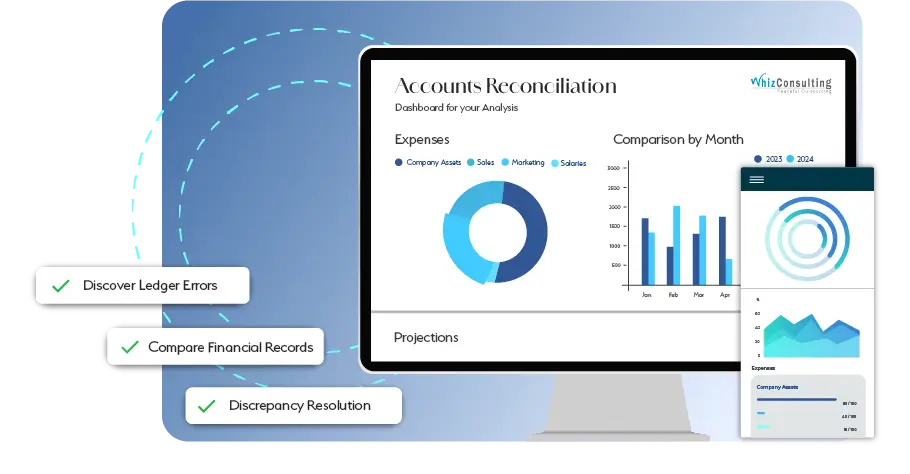-
100+
Clients Served
-
100000+
Invoices Processed Per Month
-
500+
Completed Projects
-
1000000+
Reconciliation in a Month
-
100+
Team Size
Gain Confidence with Expert Ratio Analysis
Struggling to make sense of your financial data? We’re here to simplify it. Our ratio analysis services reveal the insights hidden in your numbers, helping you understand and optimise your business. By examining key metrics like profitability, liquidity, and efficiency, we provide clarity and actionable strategies. With our tailored support, you’ll not only boost performance but also gain the confidence to seize new opportunities and stay ahead in a competitive market. Let’s turn your data into a roadmap for success!
Ratio Analysis Services We Offer
- Profitability Ratios
- Liquidity Ratios
- Efficiency Ratios
- Solvency Ratios
- Market Ratios
- Turnover Ratios
- Earnings Ratios

Overcoming Ratio Analysis Challenges with Whiz Consulting
At Whiz Consulting, we tackle the common obstacles businesses face with financial ratio analysis, transforming data into clear, actionable insights.
Complex Data Interpretation
Deciphering what ratios reveal about your business can be daunting. We break down the numbers, offering straightforward explanations to ensure stakeholders understand the financial impact.

Inaccurate Calculations
Mistakes in financial data can distort ratios and misguide decisions. Our meticulous validation processes guarantee accurate data, ensuring trustworthy and consistent results.

Limited Benchmarking Opportunities
Evaluating performance without benchmarks is tough. We provide in-depth industry comparisons, enabling you to measure progress, spot trends, and uncover opportunities for growth.


Simplify Your Business Performance Analysis
Making sense of your financial health shouldn’t be difficult. With our expert financial ratio analysis services, we transform complex figures into straightforward, actionable insights. Whether it’s profitability, liquidity, or efficiency, we provide a comprehensive view to support informed decisions, reduce risks, and highlight growth opportunities. Trust us to take care of the details while you concentrate on driving your business forward with clarity and confidence.
- Tailored Onboarding
- Seamless Integration
- Data Migration Support
- Dedicated Account Manager
- No Disruption to Operations
- Scalable Solutions
Switching to Whiz is Simple!
Switching to a new accounting partner may sound like a task, but with Whiz, it’s completely stress-free. We support you at every step, guaranteeing a seamless transition without downtime or disruptions. Leave your bookkeeping to us, so you can focus on what you do best.
Switch Now
Our Technology Partners
Empowering innovation with cutting-edge solutions designed to drive efficiency and transformation.
 Behind on
your books?
Behind on
your books?
Take advantage of Catch-Up Bookkeeping, and you’ll never feel behind on your books again.
Why Choose Us?
-

Innovative Workflow
We utilise cutting-edge technology and proven best practices to design streamlined workflows that guarantee accuracy, efficiency, and the timely delivery of your financial reports.
-

Seamless Collaboration
Our team works closely with you to ensure effective communication and a thorough understanding of your bookkeeping needs. Whether it’s a quick update or a strategic discussion, we’re always just a call away.
-

Decade of Experience
With over 10 years of industry expertise, we have a proven history of helping businesses across various sectors stay organised and financially sound.
-

Dedicated Experts
Our team comprises highly skilled and certified professionals, dedicated to supporting your business. From accountants to financial analysts, we have the expertise to tackle your unique challenges.
-

Real-Time Insights
Enjoy a clear, up-to-date view of your financial health at any time. Our real-time reporting and dashboards provide actionable insights to help you make informed decisions and drive business growth.
-

Cost Savings
Outsourcing your accounting and bookkeeping with us reduces overhead costs. Our scalable services are tailored to your needs, saving you the expense of hiring, training, and maintaining an in-house team.
Client Testimonials
See how we've helped others achieve their financial goals with personalized solutions and expert guidance.
How It Works
We simplify the process to help you achieve your financial goals with ease.
-
Seamless Transition
We ensure a smooth, hassle-free transition, minimising disruption to your operations.
-
Transparent Communication
We keep you informed at every step with clear, open communication.
-
Accurate Finances
Our team provides precise financial tracking to ensure everything stays on budget and within scope.
Have questions in mind? Find answers here...
Financial ratio analysis involves evaluating key metrics such as profitability, liquidity, and solvency to assess a business’s financial health. It helps identify strengths, weaknesses, and opportunities for growth.
Debt to asset ratio analysis evaluates how much of your business’s assets are financed by debt. It’s a vital metric for understanding financial stability and managing long-term risks.
The debt-to-equity ratio shows how a company is financing its operations, whether through debt or equity. It helps assess financial leverage and the company’s ability to meet its obligations.
Interpretation services simplify complex data, providing actionable insights from metrics like equity to debt ratio or debt to total assets. These insights guide better decision-making and strategic planning.
Yes, by regularly analysing key ratios, businesses can track performance, mitigate risks, and make informed decisions. Financial ratio analysis ensures you align your strategies with long-term growth objectives.
Thousands of business owners trust Whiz to manage their account
Let us take care of your books and make this financial year a good one.
Unlock Your Business Potential with Financial Ratio Analysis
Understanding your financial performance is essential for driving sustainable growth. Financial ratio analysis transforms complex financial data into actionable insights, empowering stakeholders to make informed decisions. By evaluating profitability, liquidity, efficiency, and solvency, businesses can pinpoint areas for improvement and uncover growth opportunities with clarity and precision.
Get a CallRatio analysis is the process of evaluating a company’s financial data to gauge its operational efficiency, financial stability, and overall health. It offers a clear picture of performance, helping stakeholders identify and address key challenges effectively.
Financial ratio analysis involves a variety of ratios, each serving a unique purpose:
Profitability Ratios: Assess a company’s ability to generate profits relative to its revenue and expenses.
Liquidity Ratios: Measure a business’s capacity to meet short-term obligations.
Efficiency Ratios: Examine how effectively resources are used to produce income.
Solvency Ratios: Evaluate long-term financial stability, including debt to total assets ratio analysis and equity to debt ratio analysis.
Market Ratios: Analyse a company’s stock value in the market.
Key metrics like analysis of debt-to-equity ratio, debt to asset ratio analysis, and debt to total assets ratio analysis are particularly important for assessing financial leverage and stability.
Ratio analysis simplifies financial data, transforming it into understandable insights. It enables business owners, managers, and investors to make well-informed decisions by highlighting strengths, weaknesses, and opportunities.
Simplifies Financial Data: Ratios provide easy-to-understand metrics, such as debt to asset ratio, which highlight key areas of performance.
Enhances Decision-Making: Ratios like equity to debt ratio help identify risks and guide growth strategies.
Monitors Trends Over Time: Regular ratio analysis reveals patterns, enabling better forecasting and performance tracking.
Supports Benchmarking: Compare your business’s performance with competitors and industry standards using financial ratio insights.
While ratio analysis offers valuable data, interpreting the results can be complex. Expert interpretation services translate these metrics into practical strategies. For example, a high debt-to-equity ratio might indicate over-leverage, highlighting the need for a more balanced approach to financing.
Improves Financial Clarity: Identify inefficiencies, monitor liquidity, and assess profitability effortlessly.
Informs Strategic Planning: Align financial metrics with long-term business objectives.
Mitigates Risks: Ratios like debt to total assets highlight potential financial risks, enabling proactive action.
Financial ratio analysis is a powerful tool for businesses aiming to optimise performance and ensure sustainable growth. By focusing on key metrics such as profitability, solvency, and efficiency, ratio analysis provides actionable insights. Whether you’re tracking trends, benchmarking performance, or addressing financial challenges, ratio analysis equips your business with the knowledge needed to thrive in today’s competitive market.














